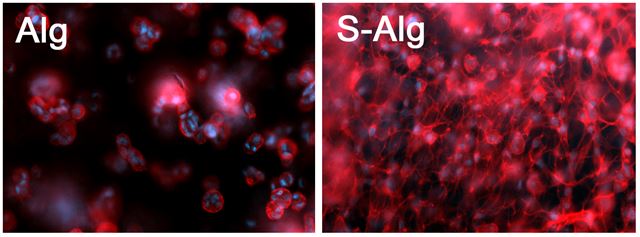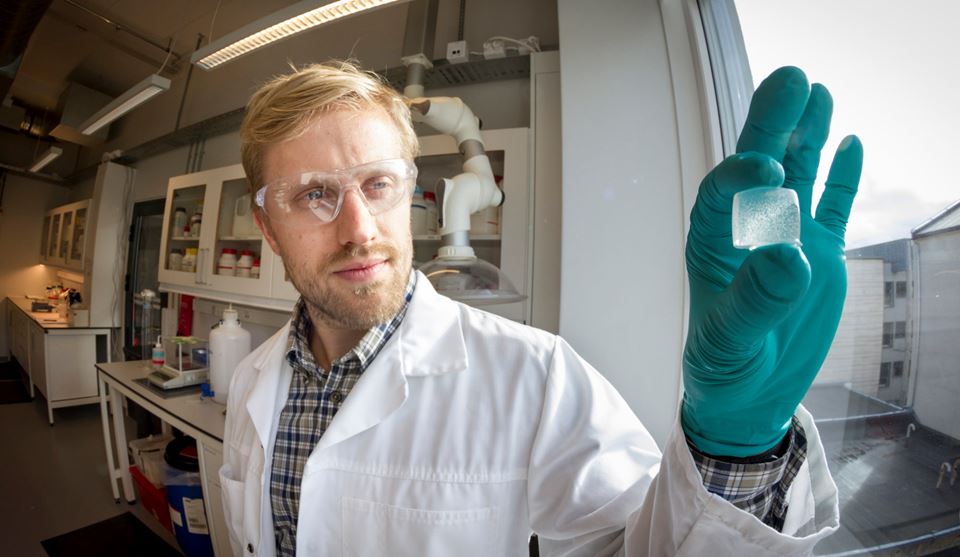
Microscope images showing cartilage tissue cells growing in alginate. The image on the right shows sulphate combined with the alginate, which promotes the formation of cartilage tissue. It also suppresses inflammatory reactions. Photo: SINTEF.
Currently there are no medications or treatments available to cure a condition that causes cartilage tissue, which acts as a shock absorber in the joints, to wear away in response to the breakdown of its collagen fibres. The condition is very painful. The stress on the bone structure in the joint becomes too great, resulting in both inflammation and minute bone fractures. About half of us will suffer from arthrosis during our lives.
The news that the research team has succeeded in growing cartilage tissue using macroalgae (brown seaweeds) as a raw material has thus attracted worldwide attention.
SINTEF researcher Øystein Arlov, who works on a daily basis with biotechnology and nanomedicine, is part of the team that has produced these sensational results. He has a Ph.D. in biopolymer chemistry from NTNU based on his studies of alginates – the gelatinous cell-wall materials found in seaweeds.
“When I was studying for my doctorate under the supervision of Professor Gudmund Skjåk-Bræk, my aim was to manipulate the structure of alginate (made up of a chain of saccharide molecules), in order to give it new biological properties”, says Arlov.
Arlov and his colleagues at SINTEF and NTNU have now succeeded in modifying the alginate so that it acts as a form of scaffold on which the cells can grow. “The cells’ natural scaffold, called an extracellular matrix, is made up of collagen and special types of carbohydrates, and it is these that break down in persons suffering from arthrosis”, explains Arlov.
Start-up funding from FIFA
Almost four years ago, Arlov was contacted by a team from the ETH Zürich technology institute in Switzerland. They had encountered his doctorate studies because they were working with a similar project for the international football federation FIFA, which is very interested in opportunities to repair cartilage in injured footballers’ knees.
FIFA has now abandoned the project, but SINTEF and the Swiss team have continued to work together and their results have recently attracted worldwide attention.
“In our laboratories we have been using brown seaweeds as our raw material”, says Arlov. “The reason for this is that seaweed alginate can form a gel that is suitable as a cell growth medium because it is similar to the cells’ natural growth environment”, he says.
But alginate cannot in itself stimulate cell growth, and this is why the researchers have been trying to make chemical modifications. They achieve this by combining sulphate, which is characteristic of the carbohydrates that occur in natural cartilage tissue. Sulphate allows the alginates to act as receptors for several key signal molecules that the cells separate out to enable them to “communicate with each other”.
The cells’ local environment is thus vital to their growth and normal function. In simple terms, we can say that these new alginates imitate nature and act to provide the cells with a message to survive, divide, and generally behave as cartilage tissue cells should.
“Using this approach, we’ve succeeded in getting the cartilage cells to survive and divide in vitro – in glass dishes in the lab”, says Arlov.
While SINTEF in Norway is manufacturing the cell growth medium, the research team in Zürich is studying the cell cultures.
“We freeze dry the material we produce and send it in powdered form to Switzerland by post,” says Arlov.
When it arrives, the sulphated alginate is dissolved in water and mixed with cells. Calcium is then added to form a gel that keeps the cells in place.
Anti-inflammatory
The results from Switzerland have been very successful, not least because the cells produced have also demonstrated that they have an anti-inflammatory effect.
This is turn has reduced the impact of so-called oxidative stress, which contributes towards accelerating the degradation of cartilage tissue. This positive effect increased with increasing sulphate content in the alginate.
The next step is to test the new materials and the lab-manufactured cartilage tissue on mice.
“Our hope is that one day we will be able to use this technology to arrest the development of arthrosis and regenerate lost cartilage tissue”, says Arlov.
Reference: Anne Kerschenmeyer, Øystein Arlov, Vera Malheiro, Matthias Steinwachs, Markus Rottmar, Katharina Maniura-Weber, Gemma Palazzolo and Marcy Zenobi-Wong. “Anti-oxidant and immune-modulatory properties of sulfated alginate derivatives on human chondrocytes and macrophages”. Biomater. Sci., 2017; 5 (9): 1756 DOI: 10.1039/c7bm00341b.


